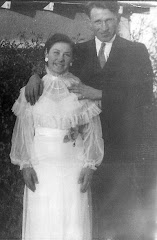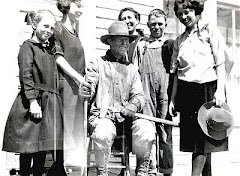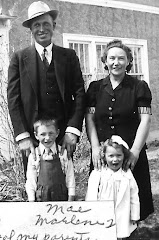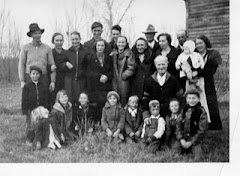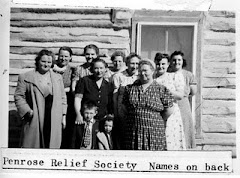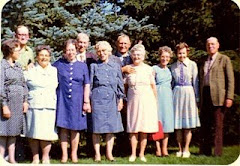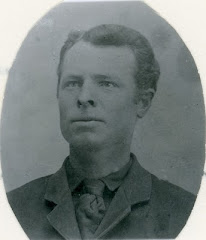 |
| John (Johannas) Christenson |
 |
| Christena Akesson Christenson |
Johannes Christenson was the eldest of three children born to Johanna Martenson and Christian Gudmundson, He was born August 16, 1826 in Krokhusetgard, Gunnarp Parish, Hallandslan, Sweden, The family were tennants there, and the whole family worked for the overlord, or owner.
When Johannes came to America he became known as John.
As a lad, John's work at the gard was that of swineherd at least part of the time. Economically, Sweden's people had little of which to boast; but they were able to get some basic education under the auspices of the Luthern (State) church, if they were members.
John's sister Magdalena was born October 27, 1830, and his brother Bengt Magnes on Sept. 19, 1934. His brother died at the age of two. His father died when he (John) was about nineteen years old.
A few years later the family heard the "Mormon" missionaries, and, recognizing the truth of the gospel, they were baptized. John was baptized by Elder Jons Olson on March 23, 1859. He was soon assigned to duties as a missionary, and continued in that work until 1861.
Naturally, John and his sister were anxious to come to America. It was not easy to save money for the trip in that land of small opportunity, where their friends had turned away from them and all was hostile to them and to the church they had joined. Perhaps the hardest of all was leaving their mother, who was too old and ill to travel, knowing they never would see her again in this life.
At last, in the spring of 1861, they were ready to begin their journey to 'Zion'. When they reached Copenhagen, Denmark, where saints gathered to take ship, Magdalena became very ill. One of the saints, Christena Nilsson Holm, took her into her home and nursed her back to health by the time they were ready to sail. The three became friends, and were passengers on the same ship, which left Copenhagen May 12, 1861.
Christena was the youngest of seven chldren. She was born August 4, 1836 at Farlov, Christianstad, Sweden. She was the daughter of Ake Nilsson and Kama Svensson, both of Opmanna, Shristianstad, Sweden.
Because work was scarce in Sweden, Christena's older-brother went to Denmark, and there he found work as a blacksmith. He took the trade name of Holm. He wrote home and told his family of his improved condition, and told them that there was plenty of work for all, so the rest of the family followed him to Denmark. Christena was then fiftenn years old. She found work in a weaving mill. From that time she went by her brother's name of Holm.
While she was working in the factory she heard the Gospel taught by the Mormon missionaries. She accepted its truths and was baptized in the North Sea, on January 8, 1856. they had to chop a hole in the ice three different places before they found water deep enough, as the ice was very thick. It was either this, or to wait, maybe for months for the elders to come that way again. There was great opposition and persecution of the Mormons and their religion. She suffered no ill effects from the cold, but did meet many trails because of her decision to join the Church. She told of a cottage meeting which had been called one evening, secretly, because of the bitter enmity of the majority of the people. Somehow news of the meeting leaked out, and as they were listening to the Elders, an ax was hurtled through the window, striking one Elder in the head, splitting his skull. The Elders poured consecrated oil into the wound and administered to him. Through the faith of those present the Lord heard their petitions; the split bones came together, the Elder recovered and was able to complete his mission.
Christena was the only one of her family to accept the gospel. The rest of the family was very bitter toward her for joining the Church. She was engaged to a young man of considerable wealth. when he heard of her 'crazy notions' he gave her a choice-either him or the church. Without hesitation she chose the church, and went to return the costly gifts he had given her. Her ring and his picture, framed in gold, he threw to the floor, stamping them to pieces in his anger, and said he would do the rest the same way. So Christena kept a few things, which she gave to her daughters many years later.
Emigrant ships were certainly not luxury liners. The passengers carried his little clothing, bedding and food for the journey, and found space for himself somewhere on the ship. They were six weeks on the ocean. At one time, during a storm, Christina fell through a man hole, or trap door which had carelessly been left open. She grabbed the edge of the opening and held on for dear life until she was found and rescued. Had she not, the ballast, shifting with the movements of the wilding pitching ship, would have crushed her.
 |
| Monarch of the Sea Ship the three friends sailed on to America |
The three friends crossed the plains together in the Hans Murdock Hancart Company of 1861*. This meant walking all the way from Omaha across Nebraska, Wyoming, and part of Utah, pushing and pulling handcarts which held all their worldly possessions, over muddy, or hot and dusty plains and rugged mountain trails. Slowly the miles fell away. Christena walked all the way, wading most of the streams and rivers until she became ill, and suffered from sore eyes; so it was ruled that she would be allowed to ride across the streams.
They arrived in Salt Lake City on Sept 8, 1861. Now they had to conquer a strange language, learn to understand a strange people, a strange land, Indian troubles, and make a home. The task seemed insurmountable!
John and Christena were married on November 2, 1861, by Bishop Davis of the Salt Lake Seventeenth Ward; and they lived in a house of his for awhile. In 1862 they moved to American Fork. They were sealed Oct. 9, 1862, in the Endowment House.
While living in American Fork the Christensons would walk into Salt Lake City twice a year to attend the General Conferences of the Church, in April and October. Then they visited with John's sister Magdalena, before the twenty-five mile hike back to their home.
Two children were born to John and Christena while they lived in American Fork. Caroline Josephine was born June 2, 1863, and Brighamine (later Minnie) was born April 21, 1865. Brighamine was premature, and it was touch and go as to whether shey would live, but due to the faith and prayers of her parents, she did live, and grew to preform a very great service as a trained nurse and midwife. She lived to be almost ninety years of age, and to her dying day she was thoughtful and helpful to those who were ill or otherwise needed her.
The companies of saints coming to Utah were sent to different localities to make their homes and build up the outlying towns; so many from the same country were sent to the same place. Among those who stopped at American Fork were Pher Hanson, his wife and sister-in-law, Johanna Herling. They were stopping in Bishop Harrington's yard when the Christensons visited them and welcomed them to Zion. On March 12, 1864, John Christenson and Johanna Herling were married in the Endowment House. Their first child, Joseph, was born April 19, 1865, at American Fork.
In 1866 the home in American Fork was sold for a new wagon and a team of oxen. The family had been called to go to Gunnison, Sanpete County, Utah, to help in the settlement of that country. Because of Indian troubles they travelled in groups. There were eight wagons in their particular group. Among the number of people who travelled with them were William and Joseph Bardsley and Sylvester Whiting. The wagons were of the scooner type, with a heavy canvas top. The women and children rode inside, while the men walked outside, carrying their guns.
This was the time of the Blackhawk war, and there was much trouble and many raids in Sanpete County; so for protection the people in Gunnison lived in the Fort for many years. John bought a house, one wall of which was the wall of the fort. Each family had one room in which to live; and as they tilled their farms they had to station guards and work in groups to guard against surprise by the Indians. Here was born to Christena, John and Tilda Christena, and to Johanna, Anna and Emma.
 |
| John Christenson Military Record - Blackhawk War |
When the Blackhawk war was over and peace had been established, John built a home for his family on Main street in Gunnison. It was built of native gray sandstone, and was built int he manner of a Duplex, having two rooms and an attic room on each side, with a private room in the middle for John. They moved into this home in 1872, and here they lived, and the children grew up.
The children were taught to respect the rights and feelings of others. There was never a distinction made of any child, and in all their lives they never felt that they were anything but whole brothers and sisters to each other.
 |
| Photo believed to be Johanna (left) and Christena (right) |
The women were active in church organizations besides taking care of their home and children, so it was a busy life. There was certainly much to be done to wrest a living from the land in that desert country. The girls learned to help their mothers in such tasks as spinning and weaving and knitting, as well as cooking and sewing, and the boys worked with their father on the farm. Any honest means which came to hand was tried to provide for the family needs. John became a farmer, a miller, a tool maker and a tool dresser. While working at the latter trade a piece of steel from a tool he was working on broke off, striking him in the eye, destroying the sight in that eye.
At the time of the "Crusade", John had to build another home for Johanna. This was build in Centerfield, on the farm, and there she finished raising her children.
John couldn't bring his family to American, but he did a great work in taking freedom to his ancestors, in getting their temple ordinances done for them. When his three sons went on missions to the Old Country, John had each of them do what he could to gather up genealogical data so the work could be done.
Part of the time that Joseph, (John's oldest son) spent in Sweden, he was in John's birthplace. Upon his return to Utah he spoke of his great admiration for his father and the great things he had accomplished here, after such poor and humble beginnings in that far away land.
John was known among his associates as a man of integrity. He lived the principles of the Gospel to the letter as he learned them. He was a kindly man, a generous neighbor. He was the president of the High Priest Quorum at the time of his death, which occured June 8, 1903, at Gunnison.
Both Christena and Johanna lived for more than two decades after his death. Christena lived in the home on Main Street, with her daughter Minnie, and she was active in the Relief Society until just a few years before she died. She died at Gunnison on Dec. 20, 1929. She was 93 years of age. Johanna died at 85, on Oct 5, 1925. She was also living in Gunnison with her daughter Anna.
* It is believed that this actually was the John R. Murdock Company, (not a handcart company).
Author Unknown
Publisher's Note: Among the few precious items Christena kept of her engagement gifts, was a Lavalierre, that was given to her youngest daughter, Cindy Sorensen. A lavalier is named for the type of pendant popularized by the Duchesse de la Vallière, a mistress of King Louis XIV of France. Within the fashion world, the name was eventually shortened to "lavalier(e)". The lavalier can be recognized most for its drop (that usually consist of a stone and or a chandelier type of drop) which is attached to the chain and not attached by a bale.)
____________________________
Source:
http://ickes-hallman.org/JohnC%20obituary.html
http://ickes-hallman.org/JohnC%20ship.html


































